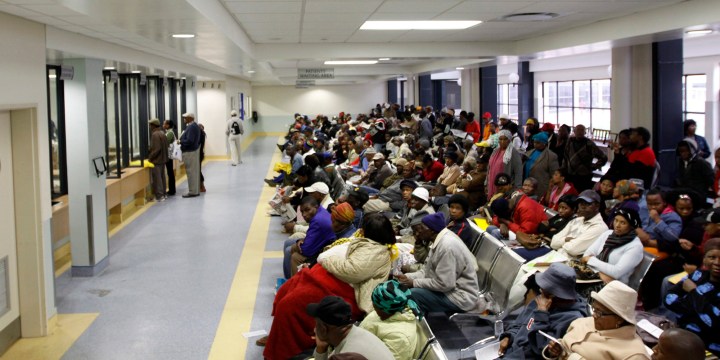Maverick Citizen: Op-ed
Why TAC wants a say in major medical negligence case

A case that may be heading to the Constitutional Court could determine whether the state can be held liable for medical negligence in certain instances. Motheo Brodie explains why the TAC is seeking to be admitted as a friend of the court in this landmark case.
A medical negligence case recently decided by the Supreme Court of Appeal has brought into question the fairness of strictly applying the legal test for causation. Applying the current test too strictly, makes it virtually impossible for the court to find in the favour of an aggrieved applicant, such as the mother of a baby who suffered brain damage, even where the negligence of a state institution is clear.
There is a worrying trend of systematic medical negligence in our hospitals. The Supreme Court of Appeal recently remarked that “far too often this court is confronted with serious and serial negligence” in hospitals falling under the respondent (Eastern Cape Department of Health)… it is clear that studied neglect of standards has become pervasive in many such hospitals. Those reliant upon their services are receiving substandard care”.
Often women are left to go into labour and give birth, often by themselves, without the appropriate level of medical care and attention. Often, in these instances, there is also negligence in record-keeping. AN obo EN v MEC for Health, Eastern Cape, is one such case.
Blatant failure
Aphelele Nontangane, a woman who was in the early stages of labour was admitted to All Saints Hospital in Ngcobo, Eastern Cape. The story of how she was treated at the hospital, while shocking, is unfortunately very common. There was a blatant failure by the staff to provide Nontangane with the appropriate care and medical attention.
The Department of Health’s own guidelines require that the heart rate of a foetus should be monitored between every second contraction. The hospital staff failed to do this.
The baby was later born with brain damage due to restriction of blood supply which led to a lack of oxygen to the brain of the foetus. As a result, the baby developed cerebral palsy.
Failure to monitor the foetal heart rate meant that staff couldn’t have known the foetus was in distress (whether they would have detected the distress is in dispute) and therefore did not expedite delivery.
In an effort to get justice and compensation for the harm suffered by her child following this negligence, Nontangane instituted a claim for damages against the state. Having not succeeded in the Eastern Cape Local Division of the High Court, the case went to the SCA, where she also lost – despite there being no real disagreement about the above facts. The matter is now heading to the Constitutional Court where Nontangane has applied for leave to appeal. A decision on whether the matter will be heard is yet to be made by the Constitutional Court.
The legal issue
Our law of delict (circumstances in which one person can claim compensation from another for harm that has been suffered) requires an aggrieved applicant to prove four elements in order to be successful in seeking compensation. First, there was an act or a failure to act (omission). Second, the act or failure to act was wrongful. Third, that the harm was as a result of either the defendants’ intention or negligence. Last, that the harm that the plaintiff suffered was factually and legally caused by the respondent (causation).
The main issue in this case and similar cases is the element of causation. In order to prove that the harm suffered was indeed caused by the negligence of the state, the patient would need to prove that without the negligent acts/omissions of the hospital staff, the harm would not have befallen the foetus. In our law, this test is called the “but-for” test.
This presents a huge obstacle for healthcare users as it can be impossible for the healthcare user to prove this, particularly when the hospital staff is so negligent that they fail to monitor the foetus’s heart rate and keep medical records. In this case, without these records, how does one prove that there were signs that the baby was indeed in distress and that the medical practitioners ought to have staged a medical intervention?
In the 2013 Constitutional Court case of Lee v Minister of Correctional Services, the Treatment Action Campaign (TAC) made arguments before the Court that there was a need for flexibility in the test for causation.
The Lee case was about a detainee (Mr Lee) who contracted tuberculosis while in prison awaiting trial. Mr Lee instituted delictual action against the Minister of Correctional Services on the premise that his infection was caused by the prisons’ poor health management. Establishing causation through the “but-for” test was unworkable for Mr Lee as he could neither locate what the specific source of his infection was nor could he prove that an adequate health management system would have altogether eliminated the risk of his infection.
The TAC argued that the “but-for” test when applied rigidly in cases where causation is unclear leads to an unfair and unjust outcome. In its judgment, the court acknowledged the need for flexibility in the causation inquiry.
Instead of using the strict “but-for” test in the Lee case the Constitutional Court as per Justice Nkabinde’s majority judgment approached the question by asking “whether the factual conditions of Mr Lee’s incarceration were a more probable cause of his tuberculosis, than that which would have been the case had he not been incarcerated in those conditions”.
However, since then our courts have been reluctant to apply the Lee test. There is a need for clarity on when the flexible test should be applied and how the test should be applied.
Friend of the court application
The TAC, represented by SECTION27, has thus made an application in the Constitutional Court to be admitted as friends of the court in the Nontangane case, should the court decide to hear it.
Among other issues, the TAC seeks to make submissions on when a flexible test should be applied by the courts, what the content of that test should be and where the onus of proof should lie in such cases.
If admitted, the TAC will make the argument that in instances where there is causal indeterminacy because of the negligence of the state and that negligence increased the risk of harm or contributed to the harm in a way that was foreseeable, the burden of proof should shift from the plaintiff having to prove that the harm was caused by the state and it should rather be shifted to the state which would have to prove that the harm suffered by the plaintiff was in fact not caused by the state.
Alternatively, the TAC will argue that when assessing whether the negligent conduct did or did not cause the harm, the court should conduct a methodical inquiry which begins by assessing whether the “but-for” test is suitable to establish causation.
Second, if the “but-for” test is unsuitable, a flexible test should be used which asks whether the increase in risk caused by the negligent conduct led to a material change in the level of risk. If indeed it did, then that is sufficient to establish causation.
Third, if it cannot be shown that it led to a material change in risk, the Court must ask whether the state’s failures which contributed to the lack of evidence, have deprived the plaintiff of their opportunity to make out their case and therefore have a fair hearing. If so, taking into consideration other factors, this will be sufficient to establish factual causation.
This flexible test would be a more fair and just method of proving causation.
The test as formulated by the TAC provides better protection and promotion of the constitutional rights of patients using the services of public hospitals. Plaintiffs in cases such as this should not be penalised because of the negligence of the state, which is so severe, that it makes it impossible for the plaintiff to obtain the evidence they need to prove their case.
The Nontangane case is unfortunately not an exceptional case. It is but one example of the systematic failures of the public health system. These failures affect patients, who are often vulnerable because of their socio-economic status, in the most horrendous ways. Public healthcare users, when seeking justice, should not be further burdened with the “but-for” causation test, especially when the state’s dysfunctionality and negligence make satisfying this test impossible. DM
Brodie is a legal researcher at SECTION27.
This article was produced for Spotlight – health journalism in the public interest.



















 Become an Insider
Become an Insider